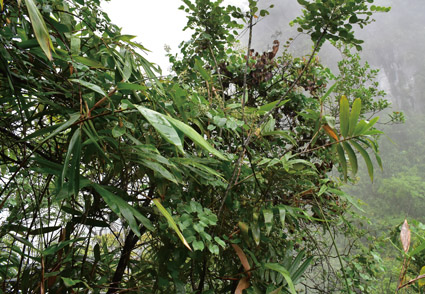Abstract
For nearly seven decades, the legume variety Phanera erythropoda var. guangxiensis (D. X. Zhang & T. C. Chen) Mackinder & R. Clark has been known solely from its type gathering, which lacked flowers and possessed only immature fruits. We report the rediscovery of this elusive variety at its type locality in Guangxi, China, including specimens bearing mature flowers. The floral characters observed diverge significantly from those of P. erythropoda, yet exhibit clear affinities with the Lasiobema group within the genus Phanera. With these new data, we provide a comprehensive description of the variety and propose elevating its taxonomic status to that of a distinct species, namely Phanera guangxiensis. We also present an updated key to all Chinese members of the Lasiobema group.
References
- Bandyopadhyay, S., Kumar, A. & Chakrabarty, T. (2021) A new combination in Phanera (Fabaceae). Annales Botanici Fennici 58 (4–6): 381–382. https://doi.org/10.5735/085.058.0425
- Bentham, G. & Hooker, J.D. (1865) Genera Plantarum ad exemplaria imprimis in herbariis Kewensibus vol. 1, pt. 2. A. Black, Londini, 735 pp.
- Chen, L. (1938) New species of Bauhinia from China. Journal of the Arnold Arboretum 19: 129–133.
- Chen, T.C. (1988) Bauhinia. In: Chen, T.C. (Ed.) Flora Reipublicae Popularis Sinicae 39. Science Press, Beijing, pp. 145–203.
- Clark, R.P. (2015) Lasiobema flavum (Leguminosae: Caesalpinioideae), a new record for the Flora of Thailand. Thai Forest Bulletin (Botany) 43: 70–73.
- Clark, R.P., Mackinder, B.A. & Banks, H. (2017) Cheniella gen. nov. (Leguminosae: Cercidoideae) from southern China, Indochina and Malesia. European Journal of Taxonomy 360: 1–37. https://doi.org/10.5852/ejt.2017.360
- de Loureiro, J. (1790) Flora Cochinchinensis 1. Typis, et expensis academicis, Ulyssipone, 394 pp.
- de Wit, H.C. (1956) A revision of Malaysian Bauhinieae. Reinwardtia 3: 381–539.
- Gu, S.R., Zeng, Q.B., Clark, R., Jiang, K.W., Pérez-Escobar, O.A., Li, S.J., Tan, W.N., Xie, Z., Mattapha, S., Shi, M.M., Wang, X.P., Zhao, Z.T., Antonelli, A., Tu, T.Y., Wen, J. & Zhang, D.X. (2024) Phylogeny and re-circumscription of Cheniella (Leguminosae: Cercidoideae) based on plastome data and morphology, with description of three new species. Taxon 73 (2): 475–502. https://doi.org/10.1002/tax.13177
- Hao, G., Zhang, D.X., Zhang, M.Y., Guo, L.X. & Li, S.J. (2003) Phylogenetics of Bauhinia subgenus Phanera (Leguminosae: Caesalpinioideae) based on ITS sequences of nuclear ribosomal DNA. Botanical Bulletin of Academia Sinica 44: 223–228.
- Hayata, B. (1913) Icones plantarum Formosanarum 3. Taihoku Bureau of Productive Industry, Government of Formosa, 222 pp.
- Jiang, K.-W., Gu, S.-R., Li, S.-J., Tu, T.-Y. & Zhang, D.-X. (2023) Three new combinations in the genus Phanera (Fabaceae: Cercidoideae) including the lectotypification of Bauhinia strychnifolia. Phytotaxa 584 (1): 52–54. https://doi.org/10.11646/phytotaxa.584.1.5
- Korthals, P.W. (1841) Bauhinia. Verhandelingen over de natuurlijke geschiedenis der Nederlandsche overzeesche bezittingen, Botanie 2: 77–92.
- Lewis, G.P. & Forest, F. (2005) Tribe Cercideae. In: Lewis, G., Schrire, B., Mackinder, B. & Lock, M. (Eds.) Legumes of the World. Royal Botanic Gardens, Kew, pp. 57–67.
- Linnaeus, C. (1753) Species Plantarum 1. Impensis Laurentii Salvii, Holmiae, 560 pp.
- Mackinder, B.A. & Clark, R. (2014) synopsis of the Asian and Australasian genus Phanera Lour. (Cercideae: Caesalpinioideae: Leguminosae) including 19 new combinations. Phytotaxa 166 (1): 49–68. http://dx.doi.org/10.11646/phytotaxa.166.1.3
- Mattapha, S., Suddee, S., Duangjai, S. & Kiewbang, W. (2022) Phanera mekongensis (Fabaceae: Cercidoideae), a new species from Thailand as supported by morphological and molecular evidence. Blumea 67: 113–122. https://doi.org/10.3767/blumea.2022.67.02.04
- Maximowicz, C.J. (1873) Diagnoses plantarum novarum Japoniae et Mandshuriae. Bulletin de l'Académie impériale des sciences de St.-Pétersbourg 18: 371–402.
- Miquel, F.A.W. (1855) Papilionaceae. In: Flora van Nederlandsch Indië. C. G. van der Post, Amsterdam, pp. 55–348.
- Miquel, F.A.G. (1852) Plantae Junghuhnianae. H.R. de Breuk, Lugduni-Batavorum, 570 pp.
- Ohashi, H. (2014) Revisions in the Japanese Leguminosae (Fabaceae). Journal of Japanese Botany 89: 197–204.
- Sinou, C., Forest, F., Lewis, G.P. & Bruneau, A. (2009) The genus Bauhinia s.l. (Leguminosae): a phylogeny based on the plastid trnL-trnF region. Botany 87: 947–960. https://dx.doi.org/10.1139/B09-065
- Sinou, C., Cardinal-McTeague, W. & Bruneau, A. (2020) Testing generic limits in Cercidoideae (Leguminosae): Insights from plastid and duplicated nuclear gene sequences. Taxon 69 (1): 67–86. https://doi.org/10.1002/tax.12207
- Trethowan, L., Clark, R. & Mackinder, B. (2015) A synopsis of the neotropical genus Schnella (Cercideae: Caesalpinioideae: Leguminosae) including 12 new combinations. Phytotaxa 204 (4): 237–252. https://doi.org/10.11646/phytotaxa.204.4.1
- Verdcourt, B. (1979) A manual of New Guinea Legumes. Botany Bulletin 11, Office of Forests, Division of Botany, Lae, Papua New Guinea, 645 pp.
- Voigt, J.O. (1845) Hortus suburbanus Calcuttensis. Bishop's College Press, Calcutta, 816 pp.
- Wunderlin, R.P. (2010a) Reorganization of the Cercideae (Fabaceae: Caesalpinioideae). Phytoneuron 48: 1–5.
- Wunderlin, R.P. (2010b) New combinations in Schnella (Fabaceae: Caesalpinioideae: Cercideae). Phytoneuron 49: 1–5.
- Wunderlin, R.P., Larsen, K. & Larsen, S.S. (1987) Reorganization of the Cercideae (Fabaceae: Caesalpinioideae). Biologiske Skrifter, DetKongelige Danske Videnskabernes Selskab 28: 1–40.
- Zhang, D. & Chen, T.-C. (1998) Three new taxa of Bauhinia (Leguminosae) from China. Nordic Journal of Botany 18 (2): 141–146. https://doi.org/10.1111/j.1756-1051.1998.tb01860.x


